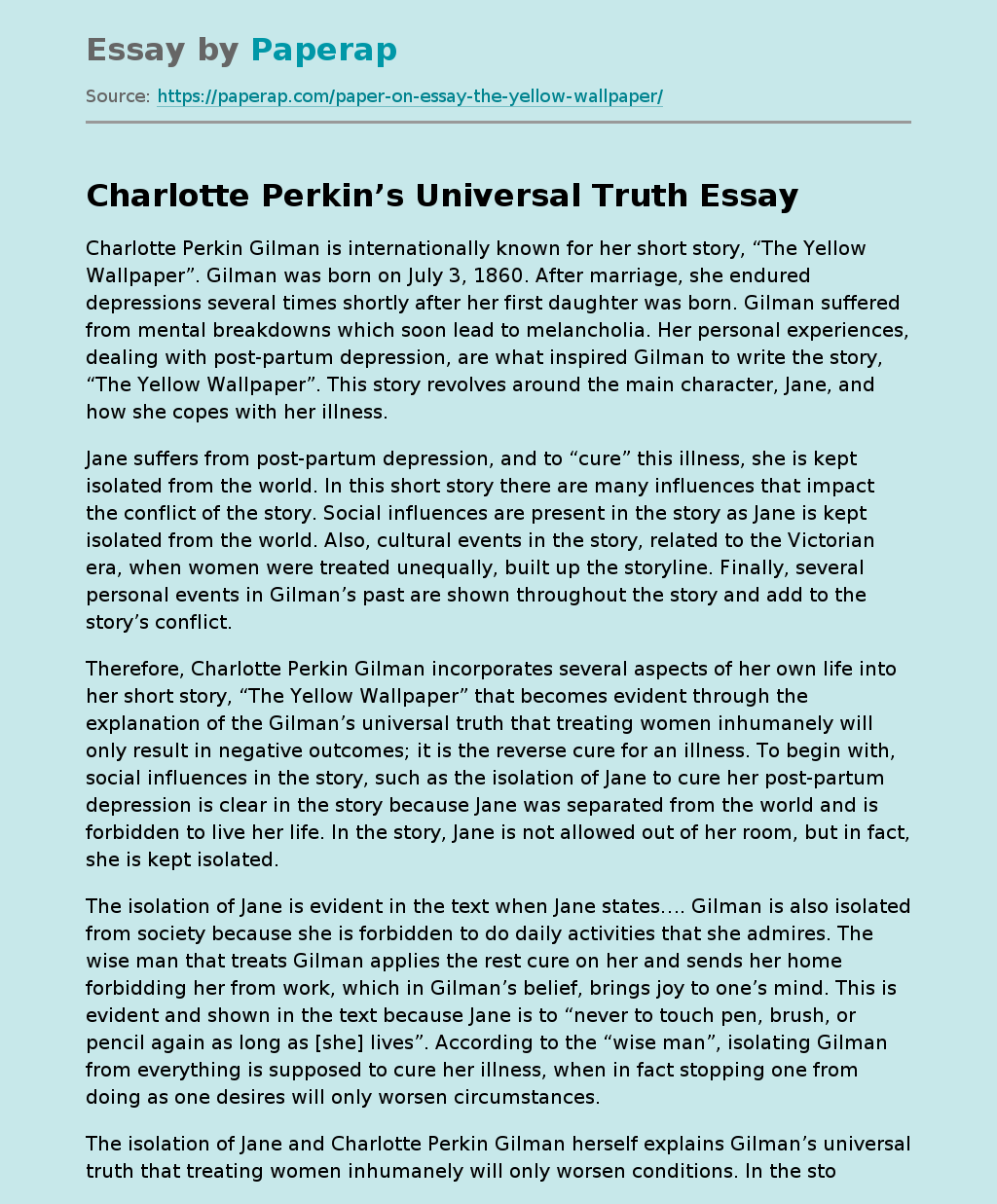Charlotte Perkin’s Universal Truth
Charlotte Perkin Gilman is internationally known for her short story, “The Yellow Wallpaper”. Gilman was born on July 3, 1860. After marriage, she endured depressions several times shortly after her first daughter was born. Gilman suffered from mental breakdowns which soon lead to melancholia. Her personal experiences, dealing with post-partum depression, are what inspired Gilman to write the story, “The Yellow Wallpaper”. This story revolves around the main character, Jane, and how she copes with her illness.
Jane suffers from post-partum depression, and to “cure” this illness, she is kept isolated from the world.
In this short story there are many influences that impact the conflict of the story. Social influences are present in the story as Jane is kept isolated from the world. Also, cultural events in the story, related to the Victorian era, when women were treated unequally, built up the storyline. Finally, several personal events in Gilman’s past are shown throughout the story and add to the story’s conflict.
Therefore, Charlotte Perkin Gilman incorporates several aspects of her own life into her short story, “The Yellow Wallpaper” that becomes evident through the explanation of the Gilman’s universal truth that treating women inhumanely will only result in negative outcomes; it is the reverse cure for an illness. To begin with, social influences in the story, such as the isolation of Jane to cure her post-partum depression is clear in the story because Jane was separated from the world and is forbidden to live her life. In the story, Jane is not allowed out of her room, but in fact, she is kept isolated.
The isolation of Jane is evident in the text when Jane states…. Gilman is also isolated from society because she is forbidden to do daily activities that she admires. The wise man that treats Gilman applies the rest cure on her and sends her home forbidding her from work, which in Gilman’s belief, brings joy to one’s mind. This is evident and shown in the text because Jane is to “never to touch pen, brush, or pencil again as long as [she] lives”. According to the “wise man”, isolating Gilman from everything is supposed to cure her illness, when in fact stopping one from doing as one desires will only worsen circumstances.
The isolation of Jane and Charlotte Perkin Gilman herself explains Gilman’s universal truth that treating women inhumanely will only worsen conditions. In the story, Jane is treated in such a manner which only worsens her condition. She is kept isolated from the world and from doing activities that she feels the need to which add on to Gilman’s illness. In conclusion, men and women should be treated equally; treating one brutally will only lead to worsen and create bigger problems. In The Yellow Wallpaper, there are many influences that impact the story’s conflict.
Social influences are evident in the story as Jane is isolated from society. Also, beliefs from the Victorian era on how women should be treated are revealed in the story. Cultural influences, the belief that man are more dominating or women are also present in the story as John looks down to Jane. Lastly, Personal influences are shown and evident in the story as Gilman’s personal experiences are reflected in the story. This short story is very significant because it shows how some treatments can lead to worsen conditions. The physician advises that Jane be kept away and isolated from any friends and family, and activities.
Doing so, only worsens Jane’s condition because she became so caught up in her own world that she begins to see creatures and shapes in the yellow wallpaper. This eventually drives her to become insane. Jane does not live a healthy life because she is not allowed to socialize with anyone, live her life and breathe freely. In order for one to live a healthy life, one needs social, physical and mental relief. Therefore, in this story, Gilman proves her universal truth that women need to be treated humanely to live a healthy life; otherwise, conditions will only worsen.
Charlotte Perkin’s Universal Truth. (2019, Jun 20). Retrieved from https://paperap.com/paper-on-essay-the-yellow-wallpaper/

